| Mar-31-06 | | paladin at large: Poor Burn! He goes into the ending a pawn up, but it is an ending with queens and the great Maroczy is in his element. Burn made the mistake, I believe, of a premature kingside pawn advance, thereby exposing his king - and Maroczy's queen pounces and plays like a cat! |
|
| Apr-01-06 | | Calli: 104.Ke1?? Burn must have been tired. 104.Kf2 and if ...Qxe7 105.Rxe7 Kxe7 106. Ke3 is drawn |
|
| Apr-01-06 | | paladin at large: <Calli> I would think Black is under no pressure to take the white e-pawn right away. If after 104. Kf2, Black plays Kg7 and h6 to exchange off the white g pawn, he should have enough resources to still win with his king heading southward escorting his g-pawn, no? An interesting position. |
|
| Apr-01-06 | | Calli: <paladin at large> The queen must keep returning to e8 and the king can't do it alone. After 104.Kf2 Kg7 105.Kf3 h5 106.gxh6+ Kxh6 107.Kg4; the only chance would be to put the King at e8 preventing the pawn promotion. But I don't see how to do that, that is, check with the Queen and then play Ke8 on the next move. |
|
| Apr-01-06 | | capanegra: Very interesting ending, but there must be a winning line for White somewhere. I have the impression that 41.g5 was a mistake. 41.gxf5 seems to be much better. For example, 41…gxf5 (41…Rd2+ 42.Kg3) 42.Rg3+ Kh6 (41…Kf8 43.Qc3) 43.Qe2 (threatening Rg5) Qh4 44.Qf2 looks fine to me. Comments? |
|
| Apr-01-06 | | Calli: <capanegra> Schlechter recommended the clever 47.Kh4! Now 47...Qxf3?? leads to mate, so White is safe from checks and should win. |
|
| Apr-02-06 | | capanegra: <Calli> 47.Kh4! is indeed a clever move. I wouldn't dare to criticize Schlechter, but is it sufficient to win? After 47…Qc7 White is forced to protect the "f" Pawn. 48.Kg3 Qa7 repeats the position, 48.Qe5 Qxe5 leads to a draw. The remaining moves are 48.Re5 Qa7 or 48.Qd4 Qc6, and I can't see how can White progress, because his King is not safe from checks yet. |
|
| Apr-02-06 | | Calli: <capanegra> Qc7 is a very good suggestion. I confess to not really looking at the position, only reading what was said aboit it. Will look at Qc7 later and see of there is a way for White to gain a tempo needed for h6. |
|
Jan-28-14
 | | wwall: Instead of 79...Qg1+, perhaps better is 79...f4. After 80.Kg4 Qg1+ 81.Kh4 Qh2+ 82.Rh3 Qf2+ 83.Kg4 h5+ 84.gxh6 Qg2+ 85.Kh4 Rd5, threatening 86...Rh5+ 87.Kxh5 Qg5 mate. |
|
| Dec-30-14 | | ColdSong: Burn has lost his nerves with 40.g4.One has really not to play that kind of weakening move without to be sure it offers no counterplay.A good lesson for the player of all level I think. |
|
Jul-28-18
 | | KEG: An extremely difficult and intriguing game. Burn completely outplayed Maroczy and eventually reached a Queen and Rook versus Queen and Rook ending (if indeed that can be called an "ending") in which he was a pawn up. Burn then erred and Maroczy obtained the upper hand. After an exhausting battle (in which Burn could have claimed a draw by triple repetition no fewer than 14 times--if I haven't miscounted) the game reduced to a remarkable Queen and two pawns verses Rook and two pawns ending that Burn might actually have been able to save--until his blunder on move 104 that led to immediate defeat. The ending here is very difficult. Even after spending a week trying to fathom the complexities of this game I am far from certain about a number of my conclusions. When I consulted Fritz and Stockfish, they were often also befuddled, frequently reaching opposing judgments and often contradicting their own analyses. The excellent work on this game by Calli, capanegra, wwall and paladinatlarge, not to mention ColdSong's apt observation, were all of great assistance to my efforts to fathom exactly what happened here. 1. d4 d5
2. c4 e6
3. Nc3 Nf6
4. Nf3 c6
Opting for a Slav formation.
5. e3 Bd6
5...Nbd7, 5...b6, and 5...Be7 were all reasonable alternatives. The text is less usual than 5...Nbd7, but is also fine for Black. Janowski would doubtless have played 5...a6 here. 6. Bd3 Nbd7
6...dxc4 would cause White to lose a tempo, but the text is OK. 7. e4
The Tournament Book assigns a "?" to this move, but it approximately as good as the more frequently played 7.Qc2 or 7. 0-0. Burn's decision to free his c1 Bishop was certainly a reasonable plan, and I am unable to understand the Tournament Book's disdain for the text. 7... dxe4
8. Nxe4 NxN
9. BxN Nf6
10. Bc2
After the exchanges following 7.e4, White had a slightly better position: 
click for larger viewWhite's small advantage notwithstanding, Maroczy had emerged with a reasonable position. But from here he began to press too hard, seemingly seeking to trade Queens. Was he seeking a quick draw or counting on being able to outplay Burn in the endgame (as in fact actually occurred here--but only after Maroczy reached what was probably a lost endgame). 10... Bb4+
This has been tried in other games and is not all that bad, but 10...Qc7 or 10...b6 were more solid. 11. Bd2 Qa5
12. 0-0
12. a3 or 12. Qe2 were also good here for White. 12... BxB
13. NxB Qh5
Did Maroczy expect Burn to trade Queens here? If so, he was to be disappointed. 13...0-0 was much better, and Maroczy soon gets a bad game. 14. Nf3
Burn, rightly, had no interest in swapping Queens. 14... 0-0
15. Re1 Rd8
16. Qd2
The position was now:

click for larger viewMaroczy could not have been happy about the position of his wandering Queen, but his position--though clearly inferior--was not all that bad. But beginning here Maroczy began playing poorly (shocking to relate) and was quickly in serious difficulties as I will discuss in my next post on this game. |
|
Jul-28-18
 | | KEG: Post II
By his 16th turn, Maroczy was apparently becoming concerned about his misplaced Queen and constricted structure. His reaction, however, only made his plight worse: 16... Ne8?
This apparent effort to break loose with f5 only makes matters worse. Maroczy should have tried to bring his c8 Bishop in the game and perhaps challenge White's center with 16...b6 or even 16...b5. 17. Re5
17. Re4 may have been even stronger.
17... Qh6
Another attempt to trade Queens.
18. Qc3 Burn still does not want to exchange, but 18. QxQ was much better, and would have shattered Maorczy's King-side pawn structure. 18... g6
Stockfish opts for 18...b6 here, but the text--allowing the Queen to find haven--seems much better. 19. Rae1 Qf8
Maroczy's position is still difficult. He might have considered 19...Qg7 or 19...f6, but the text was certainly attractive. 20. b4 b6
21. a3
21. Bb3 may have been better.
21... f6
Creating further weaknesses. Better was 21...Bb7 or 21...Nf6. 22. R5e3
The position was now:
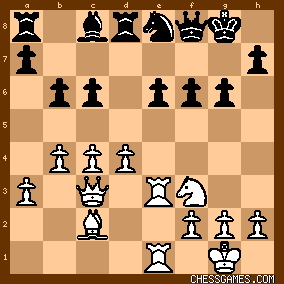
click for larger view22... a5
Maroczy, as will be seen, has a neat trick in mind, but this wild move--as Burn quickly shows--loses a pawn and should have lost the game. 23. Be4!
After this shot, Maroczy's position may have been beyond repair. But he still has his "trick" in mind. 23... axb4
24. axb4 Bd7
Maroczy may have thought that this would hold the position. If so, he was wrong. 25. b5! Rac8?
Maroczy's best chance was to sacrifice the exchange for counterplay with 25...cxb5 26. BxR RxB. Even 25...Nd6 was better than the text. Now he simply loses a pawn for no compensation whatsoever. 26. bxc6 Bxc6
27. BxB RxB
28. Rxe6 RxR
29. RxR
This left:
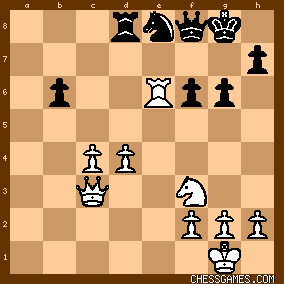
click for larger viewMaroczy is down a pawn and is obviously lost. But the game was not even 30% over yet. As will be seen, Burn could not figure out how to convert his winning advantage, and Maroczy--a fine defensive player--made Burn's task as difficult as possible. 29... Rd6
30. Re1 Nc7
31. h3 Qd8
32. Re3
This move doesn't blow Burn's win, but is an indication he is on the wrong track. He had many better plans, e.g., 32. Rb1; 32. Qb4; etc. 32... Kg7
33. d5
Another misstep. 33. Qe1 was the best way to shatter Black's defense. 33... b5!
Dynamic defense by Maroczy. Did Burn really miss this? And, if so, was his confidence a bit deflated when he realized he had allowed Maroczy to battle on a bit longer? 34. Nd4!
A game try by Burn, and the only real way to retain his winning advantage. 34... bxc4
35. Qxc4 Qd7
35...Rxd5, as the Tournament Book pointed out, would lose to 36. QxN+ (of course, 35...Nxd5 loses immediately to 36. Ne6+). The position was now:

click for larger viewThings certainly looked grim for Maroczy. But as I will discuss in my next post on this game, the struggle was about to become fascinating. |
|
Jul-29-18
 | | KEG: Post III
After 35 moves, who would have imagined this seemingly easily won game for Burn would last another 69 moves! 36. Ne6+
The trade of Knights is the surest (and perhaps the only) road to victory. 36... NxN
37. dxN Rd1+
This appears to lose a tempo, but the "better" 37...Qe7 does not lead to anything much better for Black. 38. Kh2 Qe7
39. f4
The beginning of what proves to be a losing plan for Burn (i.e., advancing his pawns). But while 39. Rb3 or 39. Re2 may be more accurate, the text did not spoil Burn's win (yet). 39... Rd8
The position was now:

click for larger viewSo far Burn is fine, but his next two moves change everything. 40. g4?!
This does not necessarily ruin Burn's winning chances, but it is difficult to disagree with what ColdSong stated on this site years ago: It is dangerous to play this kind of potentially weakening move without being sure it offers no counterplay. Before this move, Maroczy had no threats or possibility of active couonterplay. After the text, however, Maroczy suddenly has chances. 40... f5?
A mistake that could have been costly. Burn's winning chances would have been difficult at best after 40...Qd6. More seriously, 40...g5?! would have created complications that (according to Stockfish at least) might have been sufficient to save the game with best play. The text, however, should have led to quick defeat, as Capanegra pointed out on this site years ago. 41. g5?
41. gxf5! (Caoanegra's move) wins easily. Now, however, Burn's win, if it indeed is still there, is problematic at best. Locking up the King-side pawns with his King vulnerable was a bad mistake by Burn. 41... Re8
41...h5 (or 41...h6) was better.
42. Qd4+ Kg8
43. Kg3 Rd8
43...Qc7 or 43...Qb7 were better. White should now be able to win. 44. Qf6 Re8
45. h4 Qg7?
Maroczy has still not got his bearings in this ending. 45...Qa7 was better. Burn was obviously not about to trade Queens here. 46. h5 Qa7
One move too late.
The position now was:

click for larger viewCalli, following Schlechter's analysis, claims a win for White here with 47. Kh4. Capanegra questions the win, finding now winning continuation for Burn after 47...Qc7. His analysis seems correct as far as he goes (examining 48. Qe5, 48. Kg2, 48. Re5, and 48. Qd4), but he misses 48. Rf3!, which confirms the correctness of Schlechter's line. 47. Re1 also seems sufficient for White here. But instead, Burn played: 47. Kf3?
This is not necessarily fatal to Burn's winning chances, since he can bring his King back to g3 on his next move and try again. The move, however, is a sign that Burn is off track. 47... Qb7+
48. Kf2?
But this move is surely a mistake, though Maroczy does not exploit it. Burn should have played 48. Kg3 and picked up where he was two moves ago. 48... Qc7?
Missing his chance. It is hard to see how Burn could win if Maroczy had gotten his Rook in position to attack with 48...Rc8 or 48...Ra8. 49. Kg2?
Burn should have played 49. Qd4 here, which seems to win in all variations. Alternatively, Burn could have tried to return to his earlier winning chances by backtracking with 49. Kg3. The text lets Maroczy back in the game, and he now seizes his chances nicely. 49... Rf8!
50. Qd4
Burn may still be able to win, but I doubt it. At the very lest he has made his task much harder. 50... Rd8!
The only real chance to offer resistance--and a good one. 51. Qa4
This left:
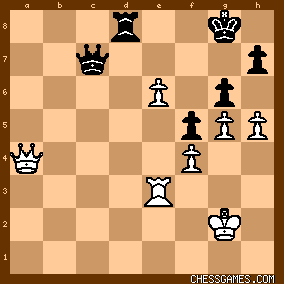
click for larger viewBurn seemingly relied on this resource. The threatened discovered check with e7+ looks devastating. But Burn never gets to play that move. As I will discuss in my next post on this game, Maroczy now invades the White camp, and Burn's awful 52nd move left him struggling for a draw. The hunted now becomes the hunter. |
|
Jul-29-18
 | | KEG: Post IV
Oops! Please excuse my last groggy comment. After 51. Qa4, there is no discovered check (I was conflating White's 51st and 53rd moves). Returning to the ACTUAL position after 51. Aa4, White may or may not still have a win, but it is problematic at best. 51... Qb7+
52. Kg3?
After this lemon, Burn's win is gone for good. His only chance to try to exploit any remaining advantage he had lay in 52. Rf3. A plausible continuation might be 52...Rd2+ 53. Kg3 gxh5 54. Qb3 QxQ 55. RxQ Re2 56. Rb5 Rxe6 57. Rxf5 leaving: 
click for larger viewCan White win this ending? Probably not. After the text, however, only Maroczy has any winning chances. In any case, back to the actual game:
52... Qh1
53. Qb3
The position now was:

click for larger viewHere is the position in which Burn had a devastating discovered check just one move away with 54. e7+. But it was not Burn's turn, and he got no chance to play e7+ since Maroczy put Burn in check on his next 41 consecutive moves. Burn should have played 53. e7 or 53. hxg6 and taken the draw that was still at hand. Now, he has to fight to avoid defeat. 53... Qg1+
54. Kf3
Anything else leads to mate.
54... Qf1+
Here and on subsequent iterations of this position, Maroczy should have played to start snatching pawns with 54...Qg4+. The move seems obvious, and it is difficult to understand Maroczy's thinking here, especially in light of the triple repetition problem I mention in my next comment. 55. Kg3 Qg1+
56. Kf3 Qf1+
57. Kg3
In what follows, Burn missed repeated chances to claim a draw by triple repetition. I will indicate each such chance by adding the notation "TR." Perhaps Burn thought he was in no danger and perhaps Maroczy would overreach himself. In any case, the numerous triple repetitions make the next part of the game extremely tedious. 57... Qg1+ (TR)
58. Kf3 (TR) Qg4+
At last Maroczy hits on the best chance. It is doubtful,however, that this should have led to victory, even though he eventually picks up a couple of pawns. 59. Kf2 Qxf4+
60. Ke2?
Another careless move by Burn that gave Maroczy real winning chances, the position now being: 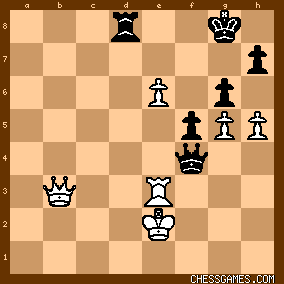
click for larger viewClearly Burn should have played 60. Rf3. But even with this error, was there a win now for Maroczy with best play in the diagrammed position. I will discuss this issue in my next post on this game. |
|
Jul-29-18
 | | KEG: Post V
What happened over the course of the next few moves after 60. Ke2? is bewildering. Maroczy has the opportunity to..and eventually does..win the White h5 pawn with a simple Queen fork. But he dallied for several moves before picking up the pawn at move 68: 60... Qh2+
The simple way to pick up the h5 pawn, which Maroczy delays doing until move 68. Was he trying to save time on the clock? 61. Ke1 Qg1+
62. Ke2 Qg2+
63. Ke1 Qg1+
64. Ke2 Qg2+
65. Ke1 Qh1+
66. Ke2
Anything else would lead to mate.
66... Qg2+ (TR)
67. Ke1 Qh1+
68. Ke2 Qxh5+
Finally! The position was now:

click for larger view69. Kf2 Qh2+
Maroczy, of course, must keep Burn's King in check to avoid the devastating e7+ discovered check. Thus, he cannot pick up the White pawn on g5. Maroczy may have a win here, but even if so, it's not easy. 70. Kf3 Qh3+
Maroczy has not yet found a way to win this ending. The best line--and perhaps the only way to win here--lay in 70...Qh1+ 71. Ke2 Qg2+ 72. Ke1 Qc1+ 74. Kf2 Rd2+ 75. Re2 Qc5+ 76. Kf1 [or 76. Ke1] RxR 77. KxR Kf8 leaving the following Queen and pawn ending: 
click for larger viewThis may be a win for Maroczy, but he would still be far from home. The line he actually chose [returning as we must to the actual game] should probably not have led to victory if not for errors by Burn. 71. Kf2 Qh2+
Maroczy now repeats the position, soon allowing Burn chances to claim a draw by repetition, opportunities Burn curiously ignored. [As before, I indicate each time Burn could have claimed a draw by triple repetition by affixing "TR" to the move]: 72. Kf3 Qh3+
Again spurning the 72...Qh1+ line mentioned above. 73. Kf2 Qh2+ (TR)
74. Kf3 (TR) Qh1+
75. Kg3?
Burn avoids 75. Ke2 which leads to the line given above, but gives Maroczy a better way to win (i.e., the line pointed out by wwall on this site years ago, but which Maroczy does not exploit until move 87, and only after giving Burn numerous chances to claim a draw by triple repetition: 75... Qg1+
76. Kf3 Qf1+
77. Kg3
This left:
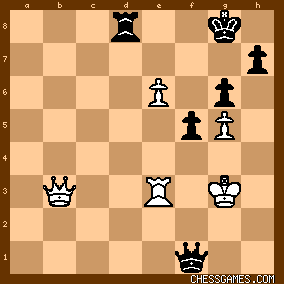
click for larger viewAs wwall has demonstrated (see his post), Black can win here beginning with 77...f4+ [actually, wwall affixed his comment to the position on move 79 after the players had repeated moves]. Maroczy seems not to have realized the power of this pawn sacrifice until move 87, after giving Burn many additional chances to claim a draw by repetition: 77... Qg1+
78. Kf3 Qf1+
79. Kg3 Qg1+
Again missing 79...f4+
80. Kf3 Qh1+
81. Kg3 Qg1+ (TR)
Yet again missing 81...f4+
82. Kf3 (TR) Qh1+ (TR)
83. Kg3 (TR) Qg1+ (TR)
Still spurning 83...f4+
84. Kf3 (TR) Qf1+ (TR)
85. Kg3 (TR) Qg1+ (TR)
Still not venturing 85...f4+
86. Kf3 (TR) Qh1+ (TR)
87. Kg3 (TR)
The position was now very similar to that after 77. Kg3 (except the Black Queen was now on h1 instead of f1. Yet here, as I will discuss in my next post on this game, Maroczy finally took the plunge and sacrificed his f-pawn for what should have been a winning advantage: 
click for larger view |
|
Jul-29-18
 | | KEG: Post VI
The game had been insufferable for quite a while, but beginning with Maroczy's 87th move, the contest became fascinating: 87... f4+
Finally trying wwall's idea! The pawn sacrifice brings the Black Rook to the attack with what should have been decisive effect. 88. Kxf4 Qh4+
88...Qh2+ would have been equally effective.
89. Kf3 Rf8+
With the Rook joining the hunt, Maroczy seemingly had the game in hand. 90. Ke2 Qf2+
91. Kd1 Qf1+
92. Kd2
The position was now:
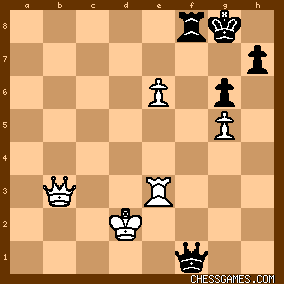
click for larger view92... Rf2+
This may or may not have theoretically blown the win for Maroczy. The simplest winning line here is 92...Qc2+ 93. Kd1 Rf1+
94. Re1 Qg4+ 95. Kc2 Rf2+ (of course not 95...RxR 96. Qb8+ and White wins!) 96. Kc1 Qxg5+ 97. Qe3 (if 97. Kb1 Qf5+ 98. Kc1 Qa5 99. e7+ Kg7 and wins) QxQ+ 98. RxQ Kf8 with a winning Rook and pawn ending. After the text, it is unclear whether Maroczy can win with best play on both sides. 93. Kc3 Qa1+
94. Kd3?
The players must have been exhausted by now or Burn would have played the much better 94. Kc4! It is unclear to me whether Maroczy could then have prevailed. 94... Rb2!
The position at this crucial juncture was now:

click for larger viewWith his discovered check idea no longer effective, Burn's goose is seemingly cooked. But the position is still tricky. 95. Qc3?
As I will attempt to show, Maroczy should now have won in short order. But what if Burn had here played 95. QxR? Sounds crazy, no? White is down Queen for Rook and White has an extra pawn. But the win is not easy. I tried to win this position against my computer, but have not been able to find a decisive line. Here is one sample of my efforts: 95. QxR QxQ 96. e7 Qb5+ 97. Kd2 Qe8 98. Ke2 Kf7
99. Rf3+ Kg7 100. Re3 h5 101. gxh6+ Kxh6 102. Rh3+ Kg5 103. Re3 Kf6 104. Rf3+ Kg7, etc. After 95. Qc3?, however, Maroczy's task was simplified--or so it would seem: 95... Qa6+!
96. Kd4 Qa4+
96...Qd6+ looks decisive. White must either play 97. Ke4 and lose his precious e-pawn or play 97. Kc4 and run into 97...Rb8. After the text, Maroczy still has work to do. He seems to think the game is over once he wins White's Queen: 97. Kd3
The position was now:

click for larger viewMaroczy here played 97...Rb3, and ran into the kind of Queen versus Rook ending that apparently--and incredibly-- is not winnable. The most promising winning line for Maroczy begins with 97...Qb5+ (98. Ke4 Qc5+ 99. Kd4 Qf4+ 100. Re4 Rd2+ 101. Kc5 Qd6+ 102. Kb5 Rd5+ 103. Ka4 Rc5 104. Rc4 Qc6+ 105. Kb3 Qxe6 106. Kb4 RxR+ 107. QxR QxQ+ 108. KxQ Kg7 109. Kd4 h6 110. gxh6+ Kxh6 with a won King and pawn ending). After the text, the win for Maroczy may well be gone (unless someone can find to win the Queen versus Rook ending with which I have struggled). 97... Rb3
98. e7 RxQ+
99. KxR Qe8
This left:
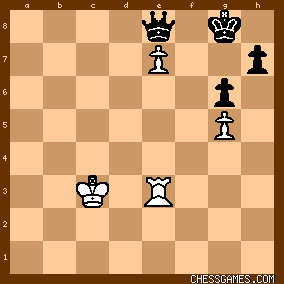
click for larger viewWhatever the theoretically correct result here, Maroczy in fact managed to prevail (with a major assist from Burn) as I will discuss in my next post on this game. |
|
Jul-29-18
 | | KEG: Post VII
The winning procedure for Black (if any) in the diagrammed position with which I ended my last post involves two elements: A) trading off Black's Queen for White's Rook and e-pawn; and B) Obtaining the opposition in the ensuing King and pawn endgame. It seems to me there must be a way to win (Fritz certainly thinks so) but even with computer assistance I haven't found a convincing winning line. In any case, picking up at the 100th move (!) of this game, it is clear that the players often lost sight of the need to have the opposition once Queen, Rook, and e-pawn were off the board. The first mishap occurred on Burn's 100th move: 100. Kd2?
This seems to lose immediately, since Burn has lost a tempo with 100. Kd2. With 100. Kd3! he keeps the opposition after 100...Kf7 101. Rf3+ Kxe7 102. Re3+ Kf7 103. RxQ+ KxR 104. Ke4 and White appears to have a draw, the position now being: 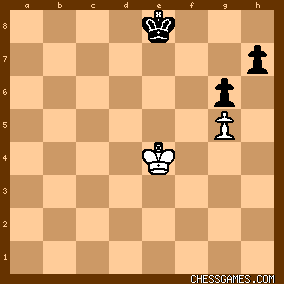
click for larger viewBut after Burn's 100. Kd2? Maorczy seems to have a win with 100...Kf7 101. Kd3 Qxe7 102. RxQ+ KxR 103. Ke4 Ke6, leaving: 
click for larger viewBlack now has the opposition and a fairly simple win (e.g., 104. Kf4 Kd5! 105. Kg4 Ke4 106. Kg3 Kf5). But Maroczy somehow missed this (in fairness, both players must have been exhausted by this stage of the game) and played: 100... Kg7?
Now, as if by magic, the win is gone.
101. Ke2 Kg8
If 101...Kf7 102. Kf2 Qxe7 103. RxQ+ KxR 104. Ke3 and White draws since he has the opposition. Following his error on move 100, Maroczy's win seems to have evaporated. 102. Ke1 Kg7
103. Ke2 Kf7
The position was now:

click for larger viewBurn still has a draw with 104. Kf2 as Calli has shown (But not 104. Rf3+ since if 104...Kxe7 105. Re3+ Kf7 106. RxQ KxR 107. Ke3 Ke7 and Black wins). After 104. Kf2 (a clever triangulation discovered by Calli, White draws after 104...Qxe7 105. RxQ KxR 106. Ke3!). If Black Queen moves after 104. Kf2, White draws by Queening the e-pawn and playing Ke2 after the resulting exchanges. But as Calli notes, "Burn must have been tired" since he played: 104. Ke1??
Now White loses the opposition and the game.
104... Qxe7!
The position was now:
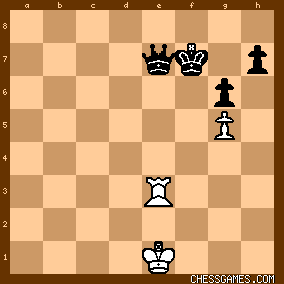
click for larger viewNow, if 105. RxQ+ KxR and Black has the opposition and wins. Of course, if White moves his King (e.g., Ke2), Maroczy would have an easy win with the simple 105...Qxg5. What a tragedy for Burn after such a long struggle. 0-1 |
|
Aug-19-18
 | | KEG: Oops
My claim that Maroczy had a win after 100. Kd2 seems flawed. If then 100...Kf7 101. Kd3 Qxe7 102. RxQ+ KxQ Burn draws with 103. Ke3 (keeping the opposition) rather than with my awful 103. Ke4 (throwing away the saving opposition). Oh well, better to have spotted this later than never! |
|
Aug-19-18
 | | KEG: Sad to say, I erred again in my last post. I gave the position to a grandmaster who immediately showed me the error of my ways. White is indeed lost after 100. Kd2?, but not for the reason I originally said. The position after 100. Kd2? was:

click for larger viewMaroczy can indeed win (as I had originally stated) with 100...Kf7! But after 101. Kd3, White can draw after 101...Qxe7 102. RxQ+ KxR but only with 103. Ke3 as I stated in my above post (and not with 103. Ke4? which only draws after 103...Ke6. What I had overlooked in the post I put up earlier today was that Black shouldn't play 101...Qxe7 after 100. Kd2? Kf7 101. Kd3 (since that allows White to draw) but should instead play 101...Qb5+ (101...Qd7+ also wins) and now if 102. Kc3 Ke8 and Black wins in a cakewalk. Oh well. I guess that's why I'm not and never will be a grandmaster! My only consolation is that Maroczy missed the win at this point as well. |
|
|
|
|





































